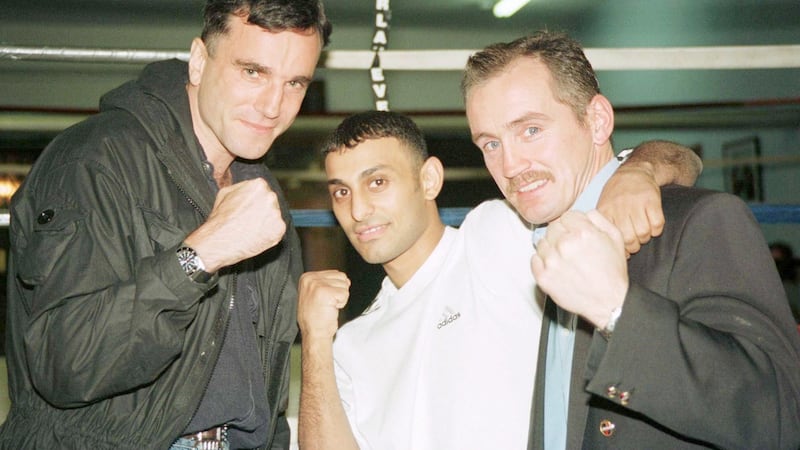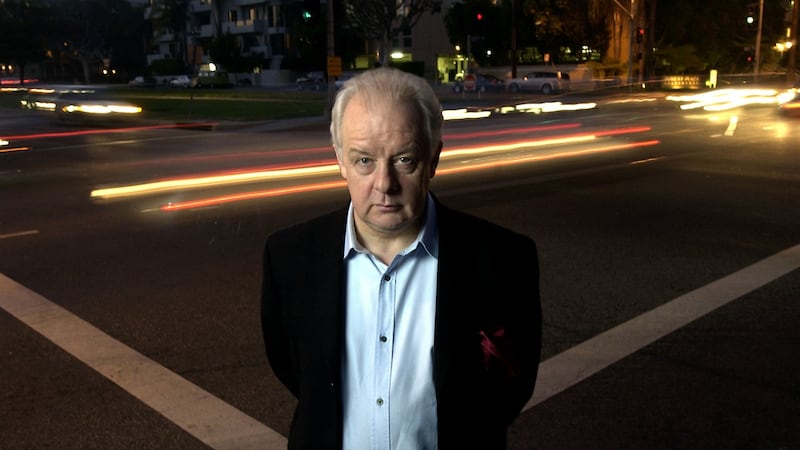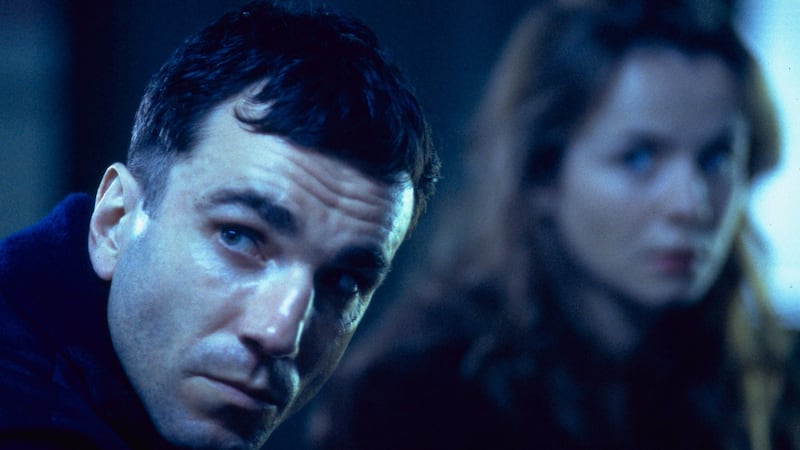It begins with a soundbite, Bill Clinton, Ian Paisley, Tony Blair and Gerry Adams declaring the perils of the peace process, set against soft classical music, then cuts to a grey prison yard where a lone hooded inmate is shadowboxing with considerable verve and menacing footwork to match, set against gentle techno and viewed through the vertical iron bars of an overlooking cell.
In 1997 Jim Sheridan originally shot that opening scene of The Boxer in slow motion, before sensing the similarity with Martin Scorsese’s Raging Bull, shot in 1980 – which in the history of cinema and the genre of sports drama where, biographical or not, boxing is still king, every film ends up being compared to.
“I can’t remember what we did and didn’t shoot in slow motion in the end. But that was the problem, you’d be shooting something and go ‘oh f***, this is so like Raging Bull’. That was tough.”
Sheridan also knew he didn’t have Robert De Niro playing the true life story of American boxer Jake LaMotta; his was a completely different film and all-Irish production anyway, loosely based and influenced by the true life story of Irish boxer Barry McGuigan, only acted out against the contemporary backdrop of the still violent Troubles and that then precarious peace process.
He also had Daniel Day-Lewis for the lead part of Danny Boy Flynn, the fictional boxer just released after 14 years in a Belfast prison. He’d d already directed Day-Lewis in My Left Foot and In The Name of the Father. That might be enough to set his film apart but certainly not any easier to make.
“The thing is when Martin Scorsese made Raging Bull, he’d just discovered the Arriflex, which was a lightweight camera. So for the first time you were really able to carry around the camera, get into the fight.
“So as you go to prepare a movie, you watch other movies, and Scorsese had used up every single little trick, slow motion, black and white, he’d wrung the Arriflix dry. So it was very daunting, and very difficult, because at that stage Daniel was probably looked upon as a competitor for De Niro.
“But we didn’t try to go head-on with Raging Bull because, if you were to talk about De Niro’s best performance, without doubt that’s it. That was a very high hurdle, so we went for a bit more documentary, more reality.”
Sheridan is telling me this over the course of a long conversation which goes off on several magnificent tangents, most of which are also off the record, and returns with clearly lasting affection to his own film (Sheridan prefers “movie”). As much as any writer-director of our time (Sheridan is a six-time Oscar nominee) he also understands why boxing more than any other sport lends itself to such visceral cinematic experience.
“It’s the movement,” he says. “With boxing, you’ve got the movement that just fits with the screen. Whereas with most other sports, you’ve got to contain games, with a moving ball. Cycling works well maybe, Daniel always wanted to play Fausto Coppi, you know?
Phone book
“It’s hard to do an original take on boxing now. I thought The Fighter, with Mark Wahlberg and Christian Bale, was very good. I think if I was to do another sporting movie it would be about bare knuckle fighting, when the gloves are off. Or there’s a movie to be made on the whole Kinahan world, where it’s corrupt, the fight between the managers is what I’d like to see.”
By 1997 the idea for The Boxer had been floating around in Sheridan’s head for years, going back to the early 1980s when he was living in Hell’s Kitchen in New York and working as a theatre director at the Irish Arts Centre.
Around then he was first drawn to the story of McGuigan, a young boxer known as the Clones Cyclone not just trying to make a name for himself but across the Catholic-Protestant divide too. Fast forward a few years and Sheridan was ringside when McGuigan beat Panamanian boxer Eusebio Pedroza for the world featherweight title at Loftus Road in June 1985.
“What happened was I was in America, and got a phone book, an Irish phonebook, and found the McGuigan name, in Clones. It was a supermarket, and I rang it. His mother answered, and I said I wanted to write a book about Barry. This was maybe three or four fights before the world title.

“So I came over, and lived with Barry in Clones for all that time, got very close to him, Barney Eastwood too, his promoter. Then did the biography of Barry, which was hard to do when he’s a 25-year-old kid at the time, called Leave The Fighting to McGuigan. I’d followed Barry all the way to his title loss in Las Vegas, against [Steve] Cruz, the Mexican fighter, where they switched the opponent at the last minute.
“Barry ended up in hospital, and I remember Bob Arum coming in [who promoted Cruz], trying to get Barry in his corner, realising then the fighting inside the ring is secondary to the fighting outside the ring.”
This in turn developed his idea of using a boxing story to tell an IRA story, specifically around the early 1990s, and the various factions for and against the peace process. The London Docklands bombing, just outside Canary Wharf, which in February 1996 ended the first 17-month peace agreement, provided one last catalyst.
To cement the two together Sheridan also added a love story, Flynn’s release after 14 years his chance to go clean and also freeing him to pursue Maggie (played by Emily Watson, who had just won an Oscar the year before for her debut film Breaking the Waves), his teenage sweetheart only now the wife of another IRA prisoner.
Their clandestine love is star-crossed not because of religion or society but politics, before they eventually push past it, Maggie’s young son Liam (played by Ciarán Fitzgerald, who Sheridan knew from Into the West) deftly adding to the conflicting loyalties, and realities of the non-sectarian Holy Family Boxing Club.
Clocking in at just under two hours, The Boxer only features three actual fights, and the first of them, which doesn’t come until almost halfway through, ends in a draw; the second ends early (with a decisive victory), the third one ends somewhere between tragedy and farce. (Here’s another comparison: in Raging Bull, the eight fight sequences only last about 19 minutes of the 129-minute film; in The Boxer, the three fight sequences only last about 10 minutes of the 113-minute film.)
Professional middleweight
There are some briefly ferocious training scenes – none that enter the realm of Rocky – only once Day-Lewis gets a hold of Danny Boy Flynn in the boxing ring there is no holding back. McGuigan was also the boxing consultant for the film, training him for a year and a half in advance (plus the other year and a half when Day-Lewis trained with the teasing possibility of making the film). By uncanny coincidence he also prepared for several months at the Crumlin Boxing Club, alongside Eamon Brown, brother of Christy Brown who he had played in My Left Foot.
By the time of the 16-week shoot, between April and July of 1997, McGuigan was convinced Day-Lewis, who had sparred over 400 rounds, was a match for any professional middleweight in the UK. Phil Sutcliffe, the two-time Irish Olympian who also trained him in Crumlin boxing club, and is boxing coach to Conor McGregor, still believes that.
“Daniel came in and trained like a professional fighter, did everything that a professional boxer needs to do,” he tells me. “And I know that because I’ve been training them in the gym for a long time now. He was 100 per cent committed, practiced everything until he got it perfect, and could land a punch, of course, his boxing ability was out of this world.”

Unlike every director before and since, Sheridan didn’t require too much effort to tempt Day-Lewis from his Wicklow retreat: “Well he loved Barry, he loved boxing. But myself, and Terry George, were writing it as we were preparing to make it, which is a tough one to do, and it was right in the middle of the peace process, it was all still happening around that time. So it was a tough movie to make, tough for me and Daniel, but I do think it’s probably one of Daniel’s best performances.
“So that [McGuigan claim’s] is no exaggeration. Daniel is like, the levels he goes to are mad. He hurt his back in that (and broke his nose), took 20 years to get better, I don’t know if it’s even better to this day. Other actors will come in and commit to something, and then pull out if they get a better offer. Daniel Day-Lewis will never commit, he’s like ‘no, I’ll look at the script, no, maybe, the script needs work . . .’
“Then he’ll come in and say ‘okay’, and when he says okay he’s like the guy who comes up off the stool, he will never not do it, never back down, never betray you, he’ll always be there for you, he’ll fight for the movie, but he’ll fight for you before himself, so he’s the easiest f***ing actor to work with, 100 per cent committed. It’s his commitment and his purity that’s so attractive, he probably has that higher than any other actor.”
Sheridan was 49 when he made The Boxer, Day-Lewis was 40, playing the part of the 32-year-old Flynn, his two opponents in the film both being former professionals; two fights against “Glasgow’s champion” Eddie Carroll (played by Damien Denny), before the London fight against the Nigerian boxer Akim Muhammed (played by Clayon Stewart), which was directly influenced by McGuigan’s experience of June 1982 when he fought Nigerian boxer Asymin Mustapha, known as Young Ali, at London’s Grosvenor House Hotel.
Both were aged 21, both had wives pregnant with their first child, and McGuigan knocked out Ali with a punch in the nose in the sixth round; he never regained consciousness, was flown back to Nigeria a month later and taken off life support.
“That fight was accurately reflected in The Boxer, which they used to have in gentlemen’s clubs in the Grosvenor House, and you could only tap your cup, and it just seemed to me the epitome of a class system, two colonials fighting each other, and the lord and lady having their champagne, not allowed to cheer.”
Sheridan also considered that tragic ending, as opposed to Flynn essentially throwing in his own towel (the only scene shot in slow motion), ending his boxing career in peaceful means in the process.
“I did think about it, but probably would have started the movie with that. I’ve also thought since how I could really make a movie about Barry, because his life has been so full of triumph and tragedy. And the first day we heard that Nika, his daughter, was not well was on that set, and Barry had to travel back and forth.”
Political stance
The Boxer is dedicated to the memory of McGuigan’s father, Pat McGuigan and brother Dermot McGuigan; Pat, famous for singing Danny Boy at his son fights, died in 1987, aged 52, from non-Hodgkin’s lymphoma; his brother Dermot, who was in Barry’s corner for that world title fight in 1985, took his own life in Clones, in 1994, aged 34.
For Sheridan, The Boxer is personal in other ways too.
“It’s as much about the politics as it is about the boxing, trying to draw a parallel between the two. I like the political stance it takes, like the integrity of the boxer, trying to fight within the rules, while the terrorist fights without rules.

“Most of the boxing people are also really sweet, probably the gentlest people you’ll meet in any sport, because it is so violent, that they have to fight within the rules. I watched it recently and was surprised, it’s so well lit, is probably the best cinematography of any movie I made up to that point. And that was Chris Menges (who won an Oscar for his work on The Killing Fields and The Mission), it looks so beautiful. And of course Sheriff Street looks fantastic as West Belfast.”
Day-Lewis also stayed in character throughout the entire shoot, as he does, something Sheridan was well used to, the only worry being when to let him snap out of it.
“After The Boxer, we had to do some reshoots, and he got a bit mad over it, because he didn’t drop the character from when we stopped filming until the reshoot. It was meant to be a few weeks, turned out to be a few months, and he’d kept the Belfast accent the whole time. When we did the last reshoot, Daniel went and shaved his head, so we couldn’t shoot anymore.”












